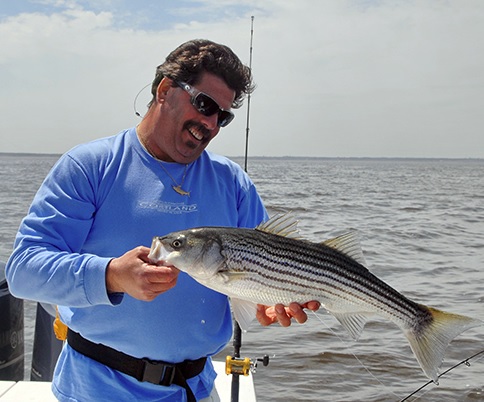 The water might be cold, but the bass are feeding. Here’s how to catch them. March might come in like a lion, but slowly warming waters are triggering striped bass to awaken from their winter metabolic slow down right now! They’re hungry, but they are not aggressive. They’re ready to eat, but not chase down prey so the best way to get their attention while enjoying some excellent early spring fishing is to key in on their scavenging instinct and break out the clams!
The water might be cold, but the bass are feeding. Here’s how to catch them. March might come in like a lion, but slowly warming waters are triggering striped bass to awaken from their winter metabolic slow down right now! They’re hungry, but they are not aggressive. They’re ready to eat, but not chase down prey so the best way to get their attention while enjoying some excellent early spring fishing is to key in on their scavenging instinct and break out the clams!
Stripers start foraging in shallow water estuaries adjacent to major spawning rivers like those in the Chesapeake Bay, Delaware Bay and the Hudson River when water temperatures nudge 40 degrees. These are fish that winter over in the estuaries and will range from a few pounds up to the high teens. Another month from now larger stripers that winter in the ocean will begin to filter back in preparation for spawning, but now it’s smaller fish, which means light tackle and light line. You don’t need a lot of specialized gear, just a couple of chum pots to hang under the boat while at anchor and a good supply of fresh, large surf clams to use for bait and chum.
The bait rigs that work the best are simple to make and consists of 30-inches of 20 or 30-pound fluorocarbon leader with a barrel swivel tied to one end and a7/0 or 8/0 light-wire circle hook on the other. Before tying the rig to your line run it through a plastic sinker slide called a “fish-finder” and clip on a bank sinker just heavy enough to hold bottom, usually an ounce or two. The sliding sinker is used because stripers will not be biting aggressively. When you do get a bite you can let the fish run a little in free spool without feeling the weight of the sinker and have a better chance of hooking up.
For this reason only use circle hooks when clam fishing, which tend to set at the very front or corner of a fish’s mouth where they are easy to remove and don’t damage vital organs. It is important to be able to release fish without hook injuries since many of them will be under the minimum size limits and chances are you’ll catch a lot more fish than current bag limits will allow you to keep.
Picking your spots to fish depends on the estuary environment, but things to look for are entrances to shallow coves, especially those that receive a lot of direct sunlight and tend to warm more quickly than surrounding waters. Look for channel edges, high spots or shallow depressions and anchor up current.
Feeding activity generally tends to be strongest on outgoing tides, which carry warm water off the flats. When the tide stops, the bite does, too. Once in position put a few clams, shells and all, in a 5-gallon bucket and crush them up. An old bat or piece of 2X4 works great for this. Then stuff them in the chum pot and hang it over the side resting on the bottom.
Shuck some clams for hook baits and thread the better part of a whole clam on the circle hook. Flip it out behind the boat, set the rod in a rod holder and bait up another outfit. The more baits in the water the more fish you will tend to attract and catch. Keep the reels in free spool and when you get a hit let the fish take for a count of five, then put the reel in gear and just come tight allowing the circle hook to work its magic. Do not try to jerk set a circle hook. You’ll only pull it out of the fish’s mouth. Keep the chum pots filled with fresh crushed clams and the action will last throughout the tide.
Clam fishing for early season stripers is great fun for everyone including children and novice anglers. It’s a fun way to start the season for anglers of all experience levels.

